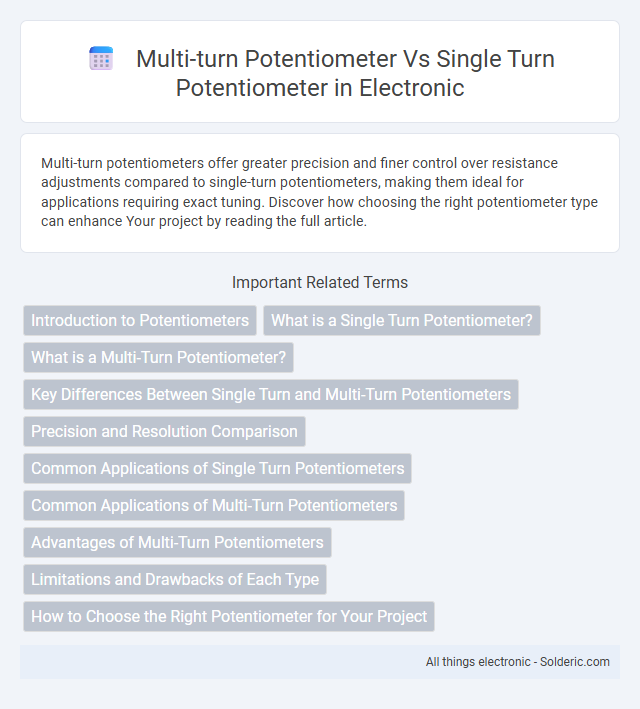Multi-turn potentiometers offer greater precision and finer control over resistance adjustments compared to single-turn potentiometers, making them ideal for applications requiring exact tuning. Discover how choosing the right potentiometer type can enhance Your project by reading the full article.
Comparison Table
| Feature | Multi-Turn Potentiometer | Single-Turn Potentiometer |
|---|---|---|
| Turns | Multiple turns (typically 5-30) | One full turn (usually 270deg) |
| Precision | High precision, fine adjustments | Lower precision, coarse adjustments |
| Resistance Range | Broad range with fine resolution | Limited range, less resolution |
| Application | Calibration, tuning, instrumentation | Volume control, simple adjustments |
| Cost | Higher due to complexity | Lower, economical choice |
| Durability | More robust for frequent use | Sufficient for general use |
| Size | Generally larger | Compact size |
Introduction to Potentiometers
Multi-turn potentiometers offer precise resistance adjustment with several rotations, enabling fine-tuning in applications requiring high accuracy, while single-turn potentiometers complete adjustment within a single 270-degree rotation. You gain enhanced control with multi-turn types, ideal for calibration tasks, compared to the quicker but less precise adjustments of single-turn potentiometers. Both serve as variable resistors to regulate voltage and current in electronic circuits but cater to distinct accuracy and adjustment speed needs.
What is a Single Turn Potentiometer?
A single turn potentiometer is a variable resistor designed to adjust electrical resistance through a single rotation, typically limited to 270 degrees. It offers precise control for applications requiring minimal adjustment ranges, such as volume controls or tuning circuits. Your choice between single turn and multi-turn potentiometers depends on the needed accuracy and range of resistance adjustment.
What is a Multi-Turn Potentiometer?
A multi-turn potentiometer allows precise adjustment of resistance through multiple rotations of its knob, typically ranging from 5 to 10 turns, enabling finer control compared to a single-turn potentiometer which only completes one full rotation. Multi-turn potentiometers are commonly used in applications requiring high accuracy, such as calibration equipment, audio devices, and instrumentation. The increased turns provide greater resolution and stability, making them ideal for delicate tuning tasks.
Key Differences Between Single Turn and Multi-Turn Potentiometers
Single turn potentiometers typically offer 270 degrees of rotation, making them ideal for quick adjustments and simple volume or tone controls, while multi-turn potentiometers provide multiple rotations, often up to 10 or more, allowing for precise, fine-tuned adjustments in applications like calibration or instrumentation. Multi-turn potentiometers generally feature higher resolution and greater mechanical durability, enabling more accurate resistance settings over a wider range compared to the limited angular movement of single turn types. Your choice between these potentiometers depends on the required precision and control in your circuit design.
Precision and Resolution Comparison
Multi-turn potentiometers offer significantly higher precision and resolution than single-turn potentiometers due to their ability to make multiple rotations, allowing finer adjustments and reduced tolerance levels. Single-turn potentiometers typically provide a resolution limited to one full rotation, resulting in coarser control and less accuracy in applications requiring exact resistance settings. The multi-turn design enables split-turn or even multiple complete turns, which improves linearity and stability, making them ideal for calibration and fine-tuning tasks.
Common Applications of Single Turn Potentiometers
Single turn potentiometers are commonly used in volume controls, tuning circuits, and sensor calibrations where precise adjustment within a limited rotation angle is required. Their simple design and cost-effectiveness make them ideal for applications in consumer electronics, audio equipment, and instrumentation. You benefit from fast, reliable adjustments when fine tuning devices without needing extended rotation ranges.
Common Applications of Multi-Turn Potentiometers
Multi-turn potentiometers are commonly used in precise calibration and tuning applications, such as in instrumentation, laboratory equipment, and audio control devices where fine adjustments are necessary. Their design allows for multiple rotations, providing higher resolution and accuracy compared to single-turn potentiometers. This makes them ideal in settings requiring detailed voltage or position control, such as in measurement devices, robotics, and aerospace systems.
Advantages of Multi-Turn Potentiometers
Multi-turn potentiometers offer enhanced precision and finer control compared to single-turn potentiometers, allowing for more accurate adjustments in applications requiring exact resistance settings. Their increased mechanical resolution, often ranging from 5 to 100 turns, enables smoother and more reliable tuning, which is essential for calibration in sensitive electronic circuits. If your project demands precise adjustment and stability, multi-turn potentiometers provide superior performance and durability over single-turn alternatives.
Limitations and Drawbacks of Each Type
Multi-turn potentiometers offer high precision and finer adjustment but are limited by their larger size, increased complexity, and slower adjustment speed compared to single-turn potentiometers. Single-turn potentiometers are compact and faster to adjust but suffer from lower resolution and reduced accuracy, making them less suitable for applications requiring fine calibration. Both types can experience wear and noise over time, but multi-turn designs typically provide more stable performance in demanding environments despite higher cost.
How to Choose the Right Potentiometer for Your Project
Choosing the right potentiometer for your project depends on the required precision and rotation range; multi-turn potentiometers provide finer adjustment with multiple rotations, ideal for applications needing high accuracy or calibration. Single-turn potentiometers offer simpler, quicker adjustments within a 270-degree rotation, suitable for basic volume controls or quick tuning. Evaluate factors like resolution, mechanical durability, and space constraints to ensure the potentiometer meets your specific performance and design requirements.
multi-turn potentiometer vs single turn potentiometer Infographic

 solderic.com
solderic.com